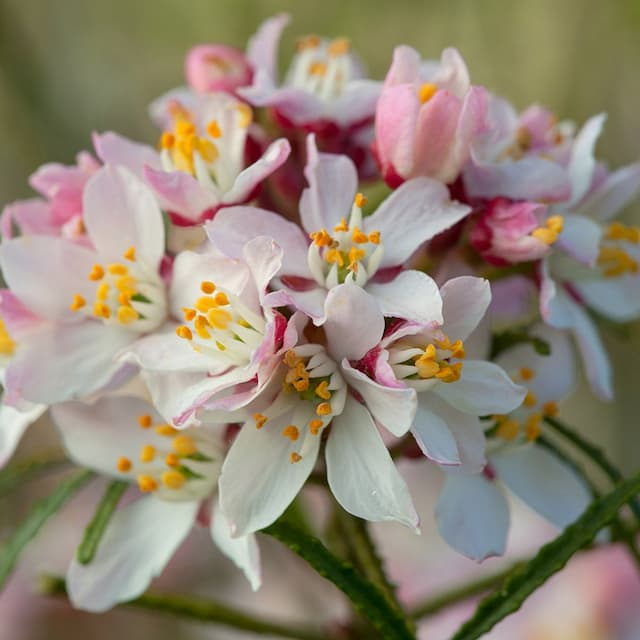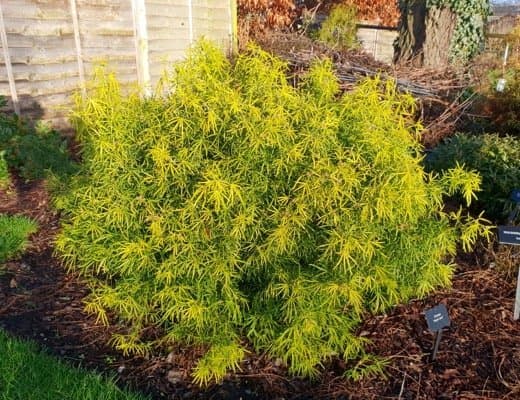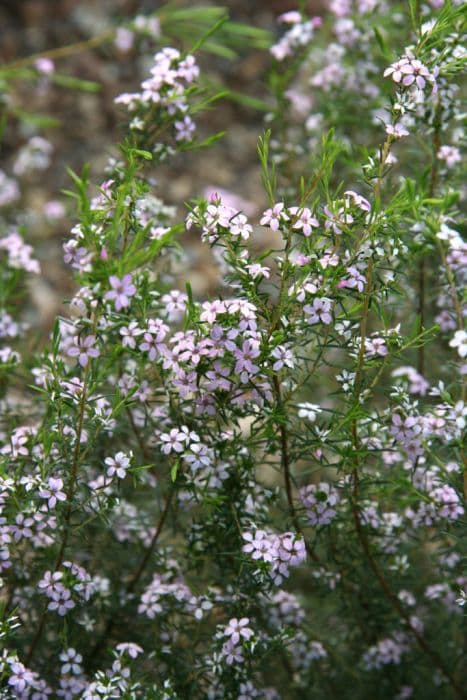Szechuan Pepper Zanthoxylum simulans

ABOUT
Zanthoxylum simulans, commonly known as the Sichuan pepper, is a distinctive plant thanks to its unique foliage and fruit that are sought after for their culinary value. This plant sports a profusion of shiny, dark green leaves that are pinnately compound, meaning they are arranged in a feather-like pattern along the central stem. Each leaf is made up of smaller, oval-shaped leaflets with slightly serrated edges, giving the foliage a textured appearance. The stems of the Sichuan pepper are adorned with small thorns that provide a protective feature against herbivores. During the blooming season, it produces clusters of tiny, inconspicuous flowers; the males and females are typically on separate plants. The flowers may be greenish-white, making them somewhat blend into the plant rather than standing out. It is the fruit of the Sichuan pepper that is most noteworthy. These small reddish-brown to bright red berries, about the size of a peppercorn, grow in dense clusters and contain a seed within. The hulls of these berries, rather than the seeds themselves, are what people commonly use in cooking, providing a distinctive tingling numbness and flavor to dishes. When dried, they appear wrinkly and dark. Overall, the Sichuan pepper's visual appeal is underscored by its attractive foliage and its small, eye-catching fruits, which can add both ornamental and practical value to gardens and culinary practices.
About this plant
 Names
NamesFamily
Rutaceae.
Synonyms
Chinese Prickly-Ash, Flatspine Prickly-Ash, Sichuan Pepper, Chinese Pepper.
Common names
Zanthoxylum bungeanum, Zanthoxylum inerme, Zanthoxylum simulans var. inerme.
 Toxicity
ToxicityTo humans
Sichuan pepper, Zanthoxylum simulans, is not generally considered toxic to humans. It is commonly used in cooking and is known for its unique tingling sensation on the palate. However, excessive ingestion of any plant material can cause gastrointestinal upset or discomfort. The essential oils in Sichuan pepper could potentially cause irritation if consumed in large quantities, leading to symptoms like nausea, vomiting, or diarrhea.
To pets
Sichuan pepper may not be significantly toxic to pets, but it is advisable to prevent them from consuming the plant. While small amounts might not cause severe problems, ingestion could potentially lead to mild gastrointestinal upset. Symptoms could include vomiting or diarrhea if a pet consumes a significant amount. It is always best to keep any spices or plant materials that are not part of a pet’s usual diet out of their reach to avoid any adverse effects.
 Characteristics
CharacteristicsLife cycle
Perennials
Foliage type
Deciduous
Color of leaves
Green
Height
10-15 feet (3-4.5 meters)
Spread
10-15 feet (3-4.5 meters)
Plant type
Shrub
Hardiness zones
6
Native area
China
Benefits
 General Benefits
General Benefits- Culinary Uses: The Zanthoxylum simulans, commonly known as Sichuan pepper, is renowned for its unique flavor profile and is extensively used in Sichuan cuisine to add a distinct, lemony taste and tingling numbness to dishes.
- Garden Aesthetics: Its beautiful foliage and ornamental qualities make it suitable for use in gardens and landscaping. The plant can provide an attractive, natural backdrop or focus point in garden design.
- Natural Insect Repellent: Sichuan pepper plants are believed to have natural insect repellent properties, which can be beneficial for keeping certain pests away from the garden or home.
- Erosion Control: The plant's root systems can help to stabilize soil and prevent erosion, making it useful in certain landscapes to safeguard against soil degradation.
- Wildlife Habitat: The Zanthoxylum simulans provides habitat and food for various wildlife species, including birds and beneficial insects, thereby contributing to the biodiversity of the ecosystem it is part of.
- Traditional Use: In some cultures, different parts of the plant such as leaves, bark, or fruits are used for traditional purposes, enhancing cultural practices and heritage.
 Medical Properties
Medical Properties- Analgesic: Zanthoxylum simulans has been traditionally used to alleviate pain.
- Anti-inflammatory: The compounds found in the plant may reduce inflammation.
- Antimicrobial: This plant may possess antimicrobial properties against certain pathogens.
- Antiparasitic: Used in folk medicine to treat parasitic infections.
- Circulatory stimulant: It is sometimes used to stimulate blood flow.
- Antifungal: There may be antifungal agents present in Zanthoxylum simulans that help combat fungal infections.
- Digestive aid: The plant has been used to aid in digestion and treat gastrointestinal problems.
- Aromatic: Though not directly a medical use, the aromatic properties may indirectly help in relaxation and stress relief.
 Air-purifying Qualities
Air-purifying QualitiesThis plant is not specifically known for air purifying qualities.
 Other Uses
Other Uses- Zanthoxylum simulans, commonly known as Sichuan Pepper, can be used as a natural pesticide due to its strong aroma and insect-repellent properties.
- The plant's bark and branches, when ground up, are used in perfumery for their unique scent that adds a spicy note to fragrances.
- The leaves of the Sichuan Pepper can be used to make a natural, aromatic dye for textiles, offering a range of earthy colors.
- The wood of Sichuan Pepper is sometimes incorporated into furniture making for its ornamental grain patterns and durability.
- Sichuan Pepper can be used in the creation of natural household cleaning products, leveraging its antibacterial qualities.
- The essential oil extracted from Sichuan Pepper is used in aromatherapy to create a stimulating and energizing atmosphere.
- It's an integral component in landscape gardening, prized for its attractive foliage and ability to attract beneficial insects.
- Culinary artists might use the numbing property of Sichuan Pepper to create unique gastronomic experiences, like numbing ice creams or cocktails.
- Leaves of the Sichuan Pepper can be placed in wardrobes or drawers as a natural moth repellent to protect clothing.
- The plant’s unique tingling sensation is used in creating culinary-theme entertainment or educational experiences, such as taste-testing events or food science demonstrations.
Interesting Facts
 Feng Shui
Feng ShuiThe plant Sichuan pepper is not used in Feng Shui practice.
 Zodiac Sign Compitability
Zodiac Sign CompitabilityThe plant Sichuan pepper is not used in astrology practice.
 Plant Symbolism
Plant Symbolism- Resilience: The plant's ability to grow in various conditions and withstand different environments symbolizes resilience and adaptability.
- Protection: With its spiny branches, the plant represents protection and defense from harm, metaphorically offering a shield against adversity.
- Healing: Traditionally used in medicine, the plant symbolizes healing and the alleviation of pain, both physical and emotional.
- Flavor and Spice in Life: Known as Szechuan pepper, it adds a distinctive flavor to food, representing diversity, excitement, and the zest of life.
- Warmth: The warming sensation the peppers bring to the palate can symbolize warmth in relationships and personal interactions.
 Water
WaterThe Sichuan pepper, Zanthoxylum simulans, should be watered when the top inch of soil feels dry to the touch. Generally, this means watering once every week or two, depending on the climate and the season. It's best to water deeply and slowly, allowing water to reach the roots without flooding the plant. An estimate would be about 1-2 gallons every watering for a medium-sized plant, adjusting according to the size of your plant and environmental conditions. It's crucial to ensure that the plant is in well-draining soil to avoid root rot from overwatering.
 Light
LightSichuan pepper plants prefer full to partial sunlight. The best spot for this plant would be an area where it receives at least six hours of direct sunlight daily, which can be supplemented with some light shade during the hottest part of the day. An east or west-facing location is ideal, ensuring the plant gets a good amount of natural light throughout the day without being exposed to too much intense afternoon sun.
 Temperature
TemperatureThe ideal temperature range for the Sichuan pepper is between 55 and 80 degrees Fahrenheit. It can withstand minimum temperatures down to around 20 degrees Fahrenheit, but growth will be best when the temperature is kept within the ideal range. Extreme heat above 95 degrees Fahrenheit should also be avoided to prevent stress to the plant.
 Pruning
PruningSichuan pepper plants should be pruned to remove any dead or damaged branches and to shape the plant for better growth. Light pruning can be done throughout the growing season, but the best time for heavier pruning is late winter or early spring, just before new growth begins. Prune the plant every year to encourage new growth and maintain a manageable size.
 Cleaning
CleaningAs needed
 Soil
SoilSzechuan Pepper (Zanthoxylum simulans) prefers a well-draining soil mix composed of loam, coarse sand, and organic matter like compost to ensure adequate nutrient content and drainage. The ideal pH range for Szechuan Pepper is between 6.0 and 7.0. Providing a layer of mulch can also help to regulate soil temperature and retain moisture.
 Repotting
RepottingSzechuan Pepper plants should be repotted every 2 to 3 years to ensure they have enough room for root growth and access to fresh nutrients. Choose a slightly larger pot each time, and repot in the spring before new growth starts.
 Humidity & Misting
Humidity & MistingSzechuan Pepper plants prefer moderate humidity levels. To achieve optimal growth, aim to maintain a humidity level of 40-60%. Avoid placing the plant in an area with dry air or near heating vents which can reduce humidity.
 Suitable locations
Suitable locationsIndoor
Ensure bright light, moderate watering, and high humidity for Szechuan Pepper.
Outdoor
Plant in sunny spot with well-draining soil and water regularly.
Hardiness zone
6-9 USDA
 Life cycle
Life cycleZanthoxylum simulans, commonly known as the Sichuan pepper, begins its life cycle as a seed, typically requiring a period of stratification to overcome dormancy. Germination follows stratification, and the seedling develops a basic root system and cotyledon leaves to harness sunlight. As the plant matures, it grows into a deciduous shrub or small tree, developing compound leaves, and a woody stem. The Sichuan pepper undergoes flowering typically in spring, where small yellow-green flowers are produced; these plants are dioecious, meaning individual plants are either male or female. Following pollination, the female plants produce distinctive reddish-brown fruits containing black seeds that can be harvested in late summer to autumn. Eventually, these seeds may disperse naturally or through human intervention, allowing the cycle to begin anew.
 Propogation
PropogationPropogation time
Spring-Early Summer
Propogation: Sichuan pepper, known scientifically as Zanthoxylum simulans, is commonly propagated through seed germination, but the most popular method is to use root cuttings. To propagate by root cuttings, one must take sections of healthy, robust roots during the plant's dormant season, typically in late winter or early spring. These cuttings, usually around 3 to 4 inches (7.5 to 10 centimeters) in length, are planted horizontally in a well-draining propagation medium. A key to success lies in maintaining consistent moisture without waterlogging and providing a stable temperature around 70°F (approximately 21°C) until new growth indicates successful root development. After the establishment of new shoots, the young plants can be hardened off and eventually transplanted to their permanent location in the garden.









